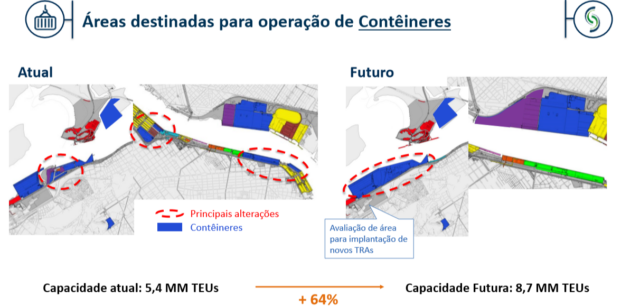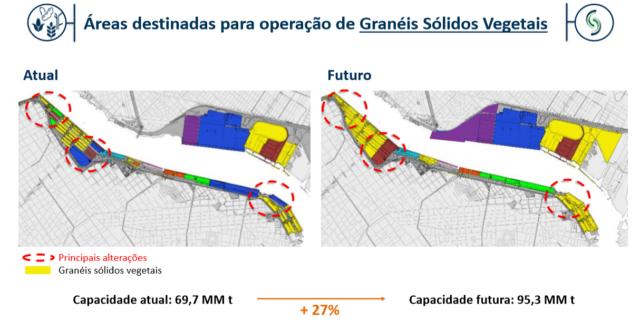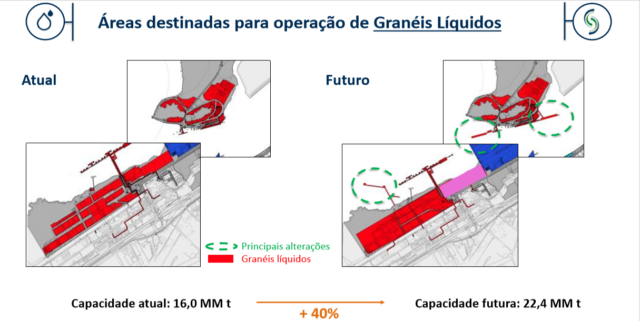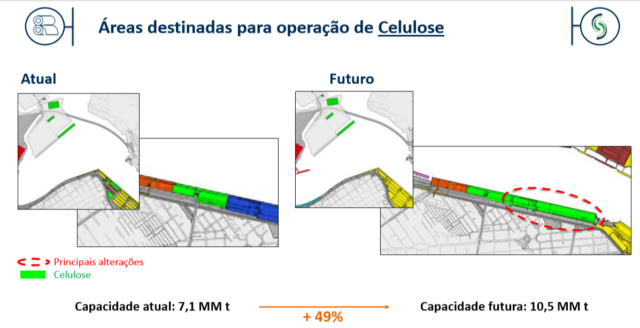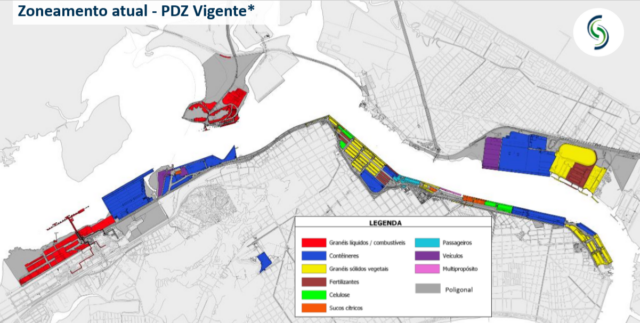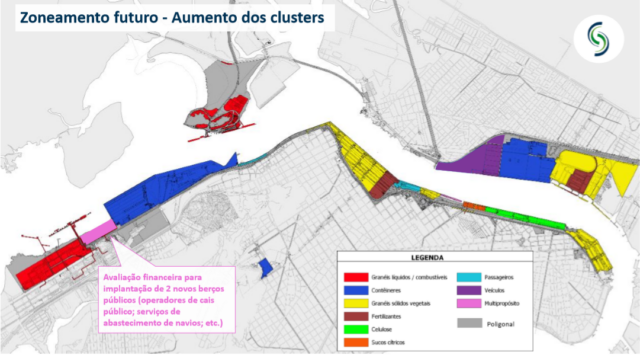
Port of Santos development plan for next 20 years
Feb, 17, 2020 Posted by datamarnewsWeek 202008
On Monday (17/02) the SPA (Santos Port Authority – new name for Codesp) presented the port’s new 20-year Development and Zoning Plan (PDZ) to the press. The plan considered operational efficiency linked to Port-City integration as its main guideline.
Container handling
Currently, 4.4 million TEU are handled in Santos, although its capacity is for 5.3 million TEU. A forecast based on GDP growth and exchange rate changes of 3.3% per year, plus increases in cabotage flows (without taking into account new demand to be created with BR do Mar), determined that in 2040 the movement of containers at Santos should reach 7.9 million TEU. This demand must be met with the implementation of a large terminal in Saboó. As a result, the container handling capacity in 2040 is expected to be 8.7 million TEU.
The map below shows the main areas for container handling at the Port of Santos and the future situation:
Solid vegetable bulk (soy, corn, bran, wheat)
Regarding solid bulk, the current movement at Santos is 61.9 million tons, with a capacity for 69.7 million tons. Projections for 2040 include movement of 81.6 million tons, with a capacity for 95.3 million tons. For this to happen, the PDZ considers modernization of the existing terminals, which will result in an increase in capacity in the short term. Adjustments will be made to areas in Paquetá, Outeirinhos and Ponta da Praia, concentrating loads, seeking to maximize rail use. With the increase in the capacity of the railroads, there is a shorter length of stay for the trains at the port, a greater number of train cycles, in addition to an increase in the rail share from 72% to 80% in the medium term. The consolidation of clusters for solid vegetable bulk will take advantage of the availability of areas, adapting terminals to receive rail transport.
The following map shows the current and future situation at the terminals dedicated to handling solid vegetable bulk in the Port of Santos:
Liquid bulk
The movement of liquid bulk at Santos is close to reaching capacity, which is 16 million tons. Auctions in the Alamoa areas and works at the terminals on Barnabé Island are expected to mitigate this capacity deficit. According to SPA, the auction of the STS08 area will make it possible to install two more berths and more storage in Alamoa. In the Barnabé Island, increased capacity will occur through the works already foreseen associated with the contracting of a berth, in addition to the implantation of up to two new berths and an increase in tank capacity as STS13 and STS13a begin operations again. The forecast is that by 2040, 22.1 million tons of liquid bulk will be handled at Santos, with a capacity of 22.4 million tons.
Check the current and future situation on the map below:
Cellulose
The current movement of pulp through the Port of Santos is 6.3 million tons, with a capacity for 7.1 million tons. For 2020, a demand of 10 million tons with a capacity of 10.5 million tons is expected. The Macuco pulp cluster should meet the demand projected for Santos in the short term, increasing the participation of the railway modal in the complex.
The STS14 and STS14A auctions will make it possible to use more berths and storage area for cellulose, meeting the demand for cargo already in the short term. Another change will be the change in rail share from 51% to 90% in the short to medium term.
It is worth remembering that the new plants announced for Santos’ region of influence would represent an increase of up to 4 million metric tons in demand, totaling around 14 MM tons in the medium term. In addition, TUP DPWorld Santos has the possibility of expanding capacity by increasing the storage area (Phase II of the Project), providing an additional dynamic capacity of 3 MM tons / year.
Below are the current and future areas for the pulp operation:
Fertilizers
SPA’s strategic proposals for the right bank of the Port of Santos will allow it to meet the identified demand for fertilizers of 3 MM tons. According to the Port Authority, there is an imbalance in the relationship between grain shipment and fertilizer unloading, considering the ports of Santos and Paranaguá that allow us to identify that this volume (3 MM t) could be captured by Santos if there was capacity.
In order to increase capacity on the right bank, it is necessary to expand storage and validate new berths (continuity of the alignment of the Outeirinhos quay). Another change is the change in the rail market share from 31% to 70% in the medium term. Currently, 9.7 million tons are handled through the Port of Santos.
Follow below the current and future situation of the areas focussed on the operation of fertilizers and other mineral bulk:
[send-gallery id = “8698”]
A new plan was also presented for the passenger terminal, the indication of areas of interest for port expansion in the future and the main changes planned for land access.
The last Zoning and Development Plan for the Port of Santos was in 2006.
-
Oil and Gas
Sep, 01, 2023
0
Bolivia announces depletion of natural gas reserves with end of exports in near-sight
-
Other Cargo
Apr, 22, 2022
0
A legislative decree wants to overturn the tax-free status of cheese imports
-
Economy
Jan, 23, 2023
0
Brazil, Argentina to encourage trade, says Finance Minister; plays down common currency
-
Ports and Terminals
Sep, 22, 2020
0
Port Terminal Rankings




